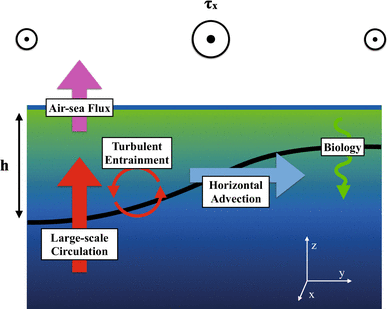story by Helen Hill for MITGCM


Diagram of the dominant carbon fluxes in and out of the Southern Ocean mixed layer – Bronselaer et al. 2018
This month we spotlight work from UK researchers Ben Bronselaer (formerly of Oxford, now at Princeton), Laure Zanna (Oxford), David Munday (British Antarctic Survey), and Jason Lowe (UK Met Office) who have been using MITgcm to understand the feedback between mixed-layer partial pressure of carbon dioxide pCO2 and wind stress in the Southern Ocean.
The Southern Ocean is the largest sink of anthropogenic carbon in the present-day climate system, acting as a giant sponge sequestering carbon dioxide out of the atmosphere and into the ocean.
Observations over the past few decades indicate that the strength of the prevailing wind in the Southern hemisphere is increasing, with coupled climate models projecting it continuing to rise into the next century.

Ben Bronselear is currently a postdoc, officially working for the University of Arizona, but stationed at GFDL in Princeton with a visiting researcher status at Princeton University. Bronselear has been using the MITgcm for several years (he says almost all of his Phd work was done with either the rectangular Atlantic box set up, or the global bathymetry 1×1 degree setup – from the biogeochemistry tutorial). In his free time, he says he likes to do a lot of photography. While at Oxford, Bronselear used to row (for the University Lightweight team) but these days looks to cycling and running for exercise, although, he says, mostly his time is taken up by studying the oceans.
To test this Bronselaer et al investigated Southern Ocean pCO2 and its dependence on wind forcing using an equilibrium mixed layer carbon budget, deriving an expression for Southern Ocean pCO2 sensitivity to wind stress, ultimately finding that Southern Ocean pCO2 varies as the square root of area-mean wind stress. To validate the implied relationship the researchers then turned to MITgcm to run idealized coarse-resolution ocean numerical experiments testing the pCO2 wind stress relationship.
Using MITgcm configured as an idealized representation of the Atlantic and Southern Oceans, the team created a 20 degree wide (in longitude) sector extending to 60 degrees North and South, incorporating a re-entrant channel between 60 and 40 degrees South to allow for a circumpolar current (refer to the paper for full configuration details.)
Key among their results, the team’s experiments demonstrate that increased (decreased) stratification through surface warming reduces (increases) the sensitivity of the Southern Ocean pCO2 to wind stress.
Finally, using their scaling to model the anthropogenic carbon sink in a suite of CMIP5 models, the researchers predict a long-term reversal of the Southern Ocean sink for large wind stress strength.
To find out more about this work contact Ben.
This Month’s Featured Publication
- Ben Bronselaer, Laure Zanna, David R. Munday, Jason Lowe (2018), Southern Ocean carbon-wind stress feedback, Climate Dynamics, doi: 10.1007/s00382-017-4041-y
Related Publication
Ben Bronselaer, Laure Zanna, David R. Munday, Jason Lowe (2016), The influence of Southern Ocean winds on the North Atlantic carbon sink, Global Biogeochemical Cycles, doi: 10.1002/2015GB005364
Other New Publications this Month
Baker, Matthew, Kivva, Kirill, Eisner, Lisa 92018), A MONITOR/TCODE Workshop on “The role of the northern Bering Sea in modulating the Arctic II: International interdisciplinary collaboration”,PICES Press; Sidney Vol. 26, Iss. 1, (Winter 2018): 15-19
Jarle Berntsen, Guttorm Alendal, Helge Avlesen, Øyvind Thiem (2018), Effects of the bottom boundary condition in numerical investigations of dense water cascading on a slope, Ocean Dynamics, doi: 10.1007/s10236-018-1138-8
Christopher L. Follett, Stephanie Dutkiewicz, David M. Karl, Keisuke Inomura and Michael J. Follows (2018), Seasonal resource conditions favor a summertime increase in North Pacific diatom–diazotroph associations, The ISME Journal, doi: 10.1038/s41396-017-0012-x
John A. Gittings, Dionysios E. Raitsos, George Krokos and Ibrahim Hoteit (2018), Impacts of warming on phytoplankton abundance and phenology in a typical tropical marine ecosystem, Scientific Reports 8, 2240, doi: 10.1038/s41598-018-20560-5
Ada Gjermundsen, Joseph H. LaCasce, and Liv Denstada (2018), The Thermally Driven Ocean Circulation with Realistic Bathymetry, Journal of Physical Oceanography, doi: 10.1175/JPO-D-17-0147.1
Lorfeld, David J. (2017), The effects of earth’s rotation on the late submarine wake, Masters Thesis, Naval Postgraduate School, Monterey
J. Mak, J.R. Maddison, D.P. Marshall, and D.R Munday (2018), Implementation of a geometrically and energetically constrained mesoscale eddy
parameterization in an ocean circulation model, arXiv: 1802.02816 [JPO]
Joao Mendonca, Matej Malik, Brice-Olivier Demory, and Kevin Heng (2018), Revisiting the Phase Curves of WASP-43B: Confronting reanalyzed Spitzer data with cloudy atmospheres, arXiv: 1802.03047
Erwan Monier, Sergey Paltsev, Andrei Sokolov, Y.-H. Henry Chen, Xiang Gao, Qudsia Ejaz, Evan Couzo, C. Adam Schlosser, Stephanie Dutkiewicz, Charles Fant, Jeffery Scott, David Kicklighter, Jennifer Morris, Henry Jacoby, Ronald Prinn & Martin Haigh (2018), Toward a consistent modeling framework to assess multi-sectoral climate impacts, Nature Communications, volume 9, Article number: 660, doi: 10.1038/s41467-018-02984-9
Bo Qiu and Shuiming Chen (2018), Seasonality in Transition Scale from Balanced to Unbalanced Motions in the World Ocean, Journal of Physical Oceanography, doi: 10.1175/JPO-D-17-0169.1
Heather C. Regan, Paul R. Holland, Michael P. Meredith, Jennifer Pike (2018), Sources, variability and fate of freshwater in the Bellingshausen Sea, Antarctica, Deep Sea Research Part I: Oceanographic Research Papers, Volume 133, Pages 59-71, doi: 10.1016/j.dsr.2018.01.005
Zhan Su, Jinbo Wang, Patrice Klein, Andrew F. Thompson & Dimitris Menemenlis (2018), Ocean submesoscales as a key component of the global heat budget, Nature Communicationsvolume 9, Article number: 775, doi: 10.1038/s41467-018-02983-w
Vasiliy Vlasenko, Nataliya Stashchuk, W. Alex M. Nimmo‐Smith (2018), Three‐Dimensional Dynamics of Baroclinic Tides Over a Seamount, Journal of Geophysical Research – Oceans, doi: 10.1002/2017JC013287
Do you have news about research using MITgcm? We are looking for contributions to these pages. If you have an interesting MITgcm project (ocean, atmosphere, sea-ice, physics, biology or otherwise) that you want to tell people about, get in touch. To make a post, contact Helen
